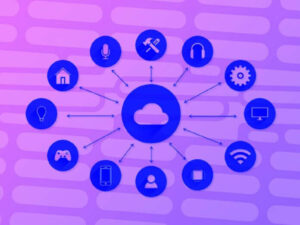
The world of smart devices and IoT is rapidly evolving and growing fast. According to the latest available data, there are approximately 13.15 billion connected IoT devices in the world today. What’s more, this figure is expected to grow to over 25 billion total IoT devices by 2030. The proliferation of connected objects continues to change the way we live, work, and play. And with more devices entering the market, creating cohesive and interactive environments has become critical in ensuring seamless communications across networks.
Matter, formerly known as “Project CHIP” (Connected Home over IP), is an open-source, royalty-free connectivity protocol that has been gaining significant traction in the IoT world. Matter has been designed to address the disconnected platforms and disparate development paths that have confused consumers and complicated processes for developers and innovators.
Put simply, it allows smart devices from different companies to communicate with each other in order to achieve the goal of ensuring smart objects are reliable, secure, and work together. As such, Matter is inherently compatible with the same environments supported by Wi-Fi HaLow, offering numerous benefits in terms of efficiency and scalability.
Understanding Matter
Matter is an IoT connectivity protocol developed by the Connectivity Standards Alliance (CSA), formerly known as Zigbee Alliance, in collaboration with major industry players like Apple, Google, Amazon, and the Thread Group. Right now, more than 180 organizations and 1,700 individuals are involved in bringing the Matter specification, reference implementations, testing tools, and certification programs to life.
Together, they’re aiming to create a unified, secure, and reliable standard for smart home devices, making it easier for consumers to build and deploy smart home ecosystems. Additionally, Matter makes it easier for device manufacturers to build devices, and to ensure they are compatible with smart home and voice services such as Amazon’s Alexa, Apple’s HomeKit with Siri, Google’s Assistant, SmartThings, and others.
This unified IP-based connectivity protocol is built on proven technologies, offering a seal of approval to IoT end-users by assuring that any object built on this standard is reliable by nature, secure by design, and compatible at scale.
The Perfect Match for Wi-Fi HaLow’s Scalability and Efficiency
Wi-Fi HaLow, which incorporates the IEEE 802.11ah standard, is one of the latest Wi-Fi protocols in the IEEE 802.11 family and was engineered specifically to meet the unique needs of IoT environments.
This low-power, long-range Wi-Fi technology was specifically designed for IoT environments and operates in the license-exempt sub-1 GHz frequency bands. It can deliver all of the benefits that consumers have come to expect from Wi-Fi today, whilst providing a tenfold increase in connectivity range, and significant power consumption reduction for thousands of devices connected to the same access point.
Like other modern Wi-Fi technologies, Wi-Fi HaLow also allows for multi-vendor interoperability, easy setup without disrupting existing Wi-Fi networks, and the latest Wi-Fi security. It is especially suited for large-scale environments, such as industrial IoT, smart agriculture, and smart cities, where efficient and reliable connectivity is crucial.
“Like other modern Wi-Fi technologies, Wi-Fi HaLow also allows for multi-vendor interoperability, easy setup without disrupting existing Wi-Fi networks, and the latest Wi-Fi security.”
As Matter is an IP-based protocol, integrating it with Wi-Fi HaLow is seamless. Both technologies are inherently compatible. To use Matter with Wi-Fi HaLow, developers need to ensure their devices support the IEEE 802.11ah standard and follow the Matter specifications when designing and implementing their smart devices and applications. Put simply, Matter runs over Wi-Fi HaLow in the same way it runs over Wi-Fi 4, 5, and 6.
The Benefits of Matter Integration in Large-Scale Wi-Fi HaLow Environments
Wi-Fi HaLow’s unique combination of energy efficiency, long-range connectivity, low latency, HD video-quality data rates, security features, and native IP support make it an ideal choice for wirelessly connected, battery-powered IoT devices deployed at scale.
- Enhanced interoperability: One of the primary advantages of using Matter in Wi-Fi HaLow environments is its ability to foster interoperability between devices from different manufacturers. With Matter, users can effortlessly build and expand their IoT ecosystems without worrying about compatibility issues.
- Improved security for IoT: Matter employs a robust, built-in security framework for things such as onboarding and over-the-air upgrades that ensures data transmissions are secure. This is crucial for large-scale IoT environments where the protection of sensitive data and privacy is of utmost importance.
- Simplified setup and management: The integration of Matter into Wi-Fi HaLow networks simplifies the setup and management of connected devices. Matter’s standardized approach streamlines device onboarding and updates, making it easier for users and administrators to manage their IoT ecosystems.
- Scalability: Matter’s compatibility with Wi-Fi HaLow enables seamless scaling of IoT deployments. As both technologies are designed to accommodate a wide range of devices and applications, they can easily adapt to the changing needs and growth of large-scale IoT environments.
As the IoT landscape continues to expand, the integration of Matter and Wi-Fi HaLow will undoubtedly play a pivotal role in shaping the future of connected devices and networks.
The combination of Matter and Wi-Fi HaLow presents a powerful and flexible solution for large-scale IoT deployments. By harnessing the strengths of both technologies, businesses, and consumers can build more efficient, secure, and interoperable smart environments.
- SEO Powered Content & PR Distribution. Get Amplified Today.
- PlatoData.Network Vertical Generative Ai. Empower Yourself. Access Here.
- PlatoAiStream. Web3 Intelligence. Knowledge Amplified. Access Here.
- PlatoESG. Automotive / EVs, Carbon, CleanTech, Energy, Environment, Solar, Waste Management. Access Here.
- BlockOffsets. Modernizing Environmental Offset Ownership. Access Here.
- Source: https://www.iotforall.com/harnessing-the-power-of-matter-for-wi-fi-halow-environments
- :has
- :is
- :where
- 1
- 11
- 13
- 15%
- 180
- 2030
- 25
- 9
- a
- ability
- About
- access
- accommodate
- According
- Achieve
- across
- adapt
- Additionally
- address
- administrators
- advantages
- agriculture
- Aiming
- Alexa
- All
- Alliance
- allows
- also
- Amazon
- an
- and
- any
- Apple
- applications
- approach
- approval
- approximately
- ARE
- AS
- Assistant
- At
- available
- become
- been
- benefits
- between
- Billion
- both
- Bringing
- build
- built
- built-in
- businesses
- by
- CAN
- Certification
- change
- changing
- choice
- Cities
- cohesive
- collaboration
- combination
- come
- communicate
- Communications
- Companies
- compatibility
- compatible
- complicated
- confused
- connected
- connected devices
- Connectivity
- Consumers
- consumption
- continues
- create
- Creating
- critical
- crucial
- data
- deliver
- deploy
- deployed
- deployments
- Design
- designed
- designing
- developed
- developers
- Development
- device
- Devices
- different
- disconnected
- disparate
- each
- easier
- easily
- easy
- Ecosystems
- efficiency
- efficient
- employs
- enables
- energy
- energy efficiency
- ensure
- ensures
- ensuring
- entering
- environments
- especially
- evolving
- existing
- Expand
- expect
- expected
- family
- FAST
- Features
- Figure
- flexible
- follow
- For
- For Consumers
- formerly
- Foster
- Framework
- Frequency
- from
- future
- gaining
- goal
- Google’s
- Group
- Grow
- Growing
- Growth
- Harnessing
- Have
- Home
- HTTPS
- ideal
- IEEE
- implementing
- importance
- in
- incorporates
- Increase
- individuals
- industrial
- Industrial IoT
- industry
- inherently
- innovators
- Integrating
- integration
- interactive
- Interoperability
- interoperable
- into
- involved
- iot
- iot devices
- IP
- issues
- IT
- ITS
- jpg
- known
- landscape
- large-scale
- Latency
- latest
- Life
- like
- live
- Low
- major
- make
- MAKES
- Making
- manage
- management
- Manufacturers
- Market
- Match
- Matter
- max-width
- Meet
- Modern
- more
- more efficient
- native
- Nature
- Need
- needs
- networks
- now
- numerous
- numerous benefits
- object
- objects
- of
- offering
- on
- Onboarding
- ONE
- open source
- operates
- order
- organizations
- Other
- Others
- over
- perfect
- pivotal
- Platforms
- plato
- Plato Data Intelligence
- PlatoData
- Play
- players
- Point
- power
- powerful
- presents
- primary
- privacy
- processes
- Programs
- protection
- protocol
- protocols
- proven
- providing
- put
- range
- rapidly
- Rates
- reduction
- reliable
- right
- robust
- Role
- royalty-free
- runs
- same
- Scalability
- Scale
- scaling
- seamless
- secure
- security
- sensitive
- Services
- setup
- shaping
- significant
- simply
- siri
- smart
- Smart Cities
- Smart home
- smart home devices
- solution
- specifically
- specification
- specifications
- standard
- standards
- strengths
- such
- support
- Supported
- Technologies
- Technology
- terms
- Testing
- than
- that
- The
- The Future
- the world
- their
- There.
- they
- things
- this
- thousands
- to
- today
- together
- tools
- Total
- traction
- undoubtedly
- unified
- unique
- Updates
- upgrades
- use
- users
- using
- Voice
- was
- Way..
- we
- when
- which
- Whilst
- Wi-fi
- wide
- Wide range
- will
- with
- without
- Work
- work together
- world
- zephyrnet










